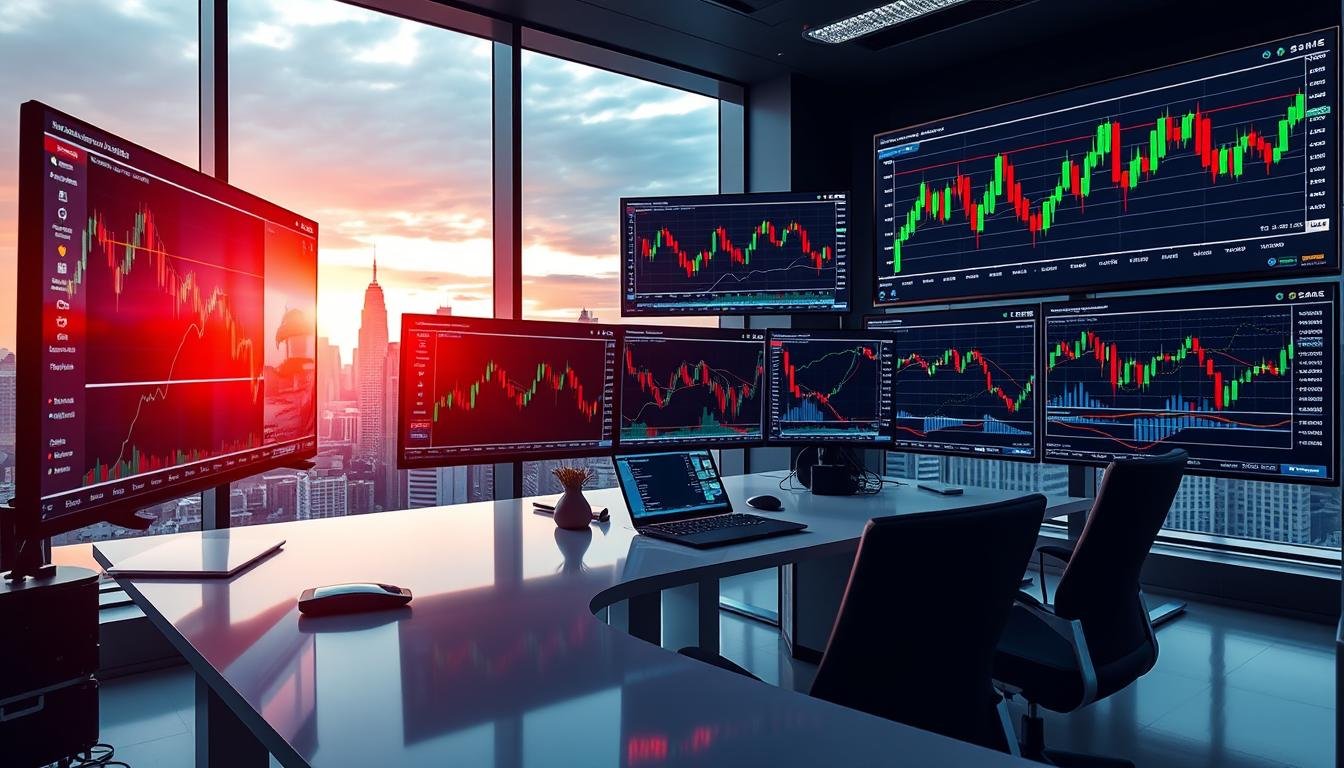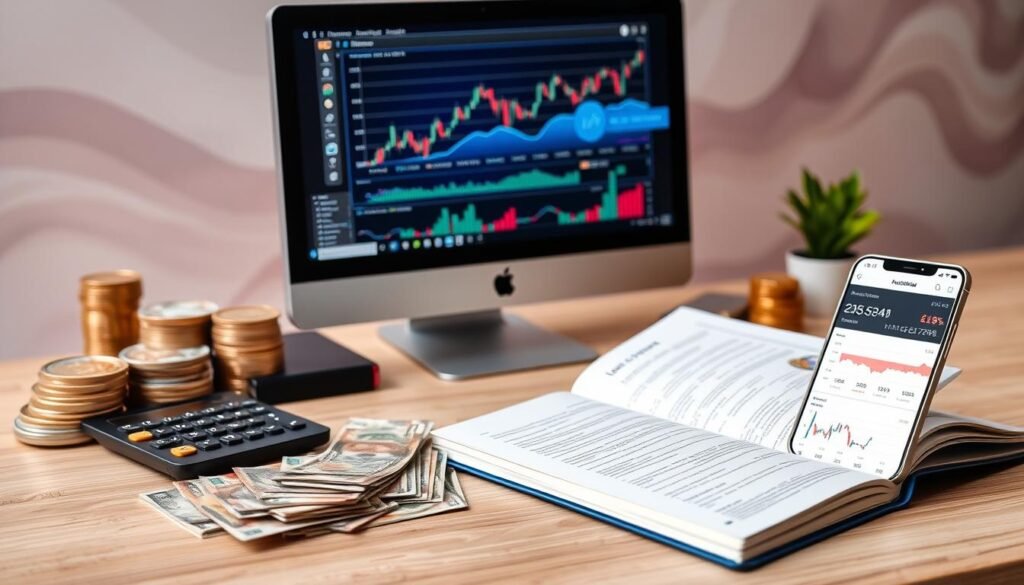Forex Trading: Learn to Trade Like a Pro
Welcome to the exciting world of forex trading! This guide is for both newbies and seasoned traders. We’ll cover the basics of forex trading, including currency pairs and technical analysis. You’ll also learn about risk management and how to succeed in trading.
The forex market is huge, with trillions of dollars traded every day. It’s a place where traders can make money by buying and selling different currencies. You’ll find many trading options, from major pairs like EUR/USD to cross-currency pairs.
Key Takeaways
- Forex trading involves the exchange of one currency for another, allowing traders to profit from fluctuations in exchange rates.
- The forex market is the largest and most liquid financial market in the world, with trillions of dollars in daily trading volume.
- Understanding currency pairs, technical analysis, and risk management strategies are essential for successful forex trading.
- Developing a well-thought-out trading plan and maintaining discipline are crucial for long-term trading success.
- Continuous education and the use of reliable trading platforms and tools can help traders stay ahead of the curve.
This guide will be your roadmap in the forex market. You’ll learn key concepts and strategies for trading. By the end, you’ll be ready to trade like a pro in the dynamic world of forex.
What is Forex Trading?
Forex trading, also known as the foreign exchange market, is a global market for trading currencies. It lets people and companies exchange one currency for another. They aim to make money from changes in exchange rates.
Understanding the Foreign Exchange Market
The foreign exchange market is the biggest and most active financial market globally. It trades over $6 trillion every day. It’s open 24/7, 5 days a week, and doesn’t have a single place where trades happen.
Key Participants in the Forex Market
- Banks and financial institutions: These are the major players in the forex market, accounting for a significant portion of daily trading volume.
- Multinational corporations: Companies engaged in international trade and investments often use the forex market to manage their currency exposure and mitigate risk.
- Retail investors: Individual traders, also known as retail investors, participate in the forex market through online trading platforms and brokers.
- Central banks: These government entities play a crucial role in the forex market, implementing monetary policies that can impact currency values.
The foreign exchange market is a dynamic and complex ecosystem, where the exchange of currencies is the primary focus. Understanding the key participants and the overall structure of the fx market is essential for any forex trading endeavor.
Forex Trading: The Basics
Forex trading, or the foreign exchange market, is a global marketplace for currencies. It’s the biggest financial market, with over $6 trillion traded daily. Knowing the basics of forex trading is key for anyone wanting to join this fast-paced world.
At the heart of forex trading are currency pairs. These show how one currency compares to another, like the Euro (EUR) and the US Dollar (USD). Traders try to make money by buying and selling these pairs when exchange rates change.
Forex trades are made through trading platforms. These platforms give traders live market data, order placement, and tools to help make decisions. Brokers’ platforms are essential for trading in the forex market.
“Forex trading is a game of probabilities, not certainties. Mastering the art of risk management is the key to long-term success.”
Learning the basics of forex trading helps traders understand currency pairs, exchange rates, and platforms. This knowledge lets them move through the complex forex market with more confidence and skill.
| Currency Pair | Description |
|---|---|
| EUR/USD | The most heavily traded currency pair, representing the value of the Euro relative to the US Dollar. |
| USD/JPY | The second most traded currency pair, reflecting the value of the US Dollar against the Japanese Yen. |
| GBP/USD | The third most traded currency pair, showcasing the relationship between the British Pound and the US Dollar. |
Currency Pairs and Quotes
In the world of forex trading, exchanging one currency for another is called a currency pair. These pairs show the value of one currency compared to another. This lets traders guess how exchange rates will change. Knowing about different currency pairs and how to read forex quotes is key for trading success.
Major Currency Pairs
The major currency pairs are the most traded and liquid in the forex market. They usually involve the US dollar (USD) with other big global currencies like the Euro (EUR) and Japanese Yen (JPY). These pairs have high trading volumes and small spreads, making them good for both new and experienced traders.
Cross Currency Pairs
Cross currency pairs don’t include the US dollar. They are less liquid and might have wider spreads than major pairs. Examples are the EUR/GBP and GBP/JPY. Though they can be tricky, they offer chances for unique trading strategies and diversification.
| Currency Pair | Description | Example Forex Quote |
|---|---|---|
| Major Currency Pair | US Dollar (USD) paired with another major global currency | EUR/USD = 1.2050 |
| Cross Currency Pair | Currency pair that does not involve the US Dollar | EUR/GBP = 0.8720 |
Understanding forex quotes is vital for knowing currency values and making smart trading choices. Forex quotes show the exchange rate between two currencies. The first currency is the base, and the second is the quote. By learning to read and analyze these quotes, traders can spot opportunities and manage risks.
Technical Analysis for Forex Trading
Technical analysis is key in forex trading. It helps traders spot trends and patterns. This way, they can find good trading chances. By looking at currency pair charts and technical indicators, traders can make smart choices.
Chart Patterns and Indicators
Forex traders use chart patterns and technical indicators to find important info. Chart patterns like head and shoulders and triangles show trend changes. They help traders know when a trend might start or end.
Technical indicators like moving averages and the relative strength index (RSI) give insights on currency pair strength. They help traders see when a pair is overbought or oversold. This info helps in finding support and resistance levels.
| Technical Indicator | Description | Application in Forex Trading |
|---|---|---|
| Moving Averages | Smoothing out price data to identify trends | Identify the direction and strength of a trend |
| Relative Strength Index (RSI) | Measures the momentum of a currency pair | Identify overbought and oversold conditions |
| Stochastic Oscillator | Compares a currency pair’s closing price to its price range over a given time period | Identify potential trend reversals and support/resistance levels |
Using technical analysis, forex traders can make better choices. Knowing about chart patterns and technical indicators is crucial. It helps them navigate the fast-paced forex market.
Fundamental Analysis in Forex Trading
In the fast-paced world of forex trading, knowing fundamental analysis is as important as technical analysis. Technical analysis looks at charts and indicators. But, fundamental analysis digs into economic indicators and forex market factors that affect currency prices.
Exploring the fundamentals helps traders understand the market’s underlying forces. This includes global events, political news, interest rates, and inflation data. Knowing these fundamental factors helps traders make better, strategic choices.
Now, let’s look at some key parts of fundamental analysis in forex trading:
- Macroeconomic Indicators: Things like GDP growth, employment rates, and consumer confidence show a country’s economic health. This affects its currency’s value.
- Monetary Policy: Central banks’ actions, like interest rates and quantitative easing, greatly influence currency strength.
- Geopolitical Events: Big political news, trade deals, and global crises cause market volatility. Investors look for safe currencies or adjust their positions.
By watching and analyzing these fundamental factors, traders get a deeper understanding of the forex market. This helps them spot trading chances, manage risks, and make better strategy decisions.
“Fundamental analysis is the foundation of successful forex trading. By grasping the big economic and political forces, traders can outsmart the ever-changing forex market.”
Combining technical and fundamental analysis gives forex traders a complete view of the market. This way, they can make more informed, profitable trades.
Risk Management Strategies
Effective risk management is key to successful forex trading. By using good risk management, traders can cut down on losses. This helps protect their capital and leads to long-term success.
Stop-Loss and Take-Profit Orders
Stop-loss and take-profit orders are vital tools in forex trading. Stop-loss orders close a trade when it hits a set price, capping losses. Take-profit orders close a trade when a profit goal is met, securing gains.
Proper Position Sizing
Proper position sizing is another crucial strategy. It’s about figuring out the right trade size based on account balance, risk tolerance, and market volatility. This way, traders avoid risking too much and control potential losses.
| Risk Management Strategy | Description | Benefits |
|---|---|---|
| Stop-Loss Orders | Automatically close a position when the market reaches a predetermined price, limiting potential losses. | Protects capital, limits downside risk, and helps manage emotions during volatile market conditions. |
| Take-Profit Orders | Automatically close a position when a specific profit target is reached, helping traders lock in their gains. | Allows traders to capitalize on profitable trades and manage their risk-reward ratio effectively. |
| Proper Position Sizing | Determining the appropriate size of each trade based on factors such as account balance, risk tolerance, and market volatility. | Prevents overexposure of capital, minimizes the impact of potential losses, and supports consistent trading performance. |
By using these risk management strategies, traders can manage their risk better. This disciplined approach improves their chances of long-term success in forex trading.

“Successful forex trading is not just about finding the right opportunities, but also about managing the risks effectively.”
The Impact of Leverage in Forex Trading
Forex trading lets traders use forex leverage to control big positions with less capital. But, this can greatly affect both profits and losses. So, managing risk well is key to doing well in forex trading.
Leverage in forex can be from 1:2 to 1:500. This means a trader can manage a $500 position with just $1 of their own trading capital. While it can increase gains, it also increases losses. If not managed right, it can quickly empty a trader’s account.
| Leverage Ratio | Margin Requirement | Potential Gain/Loss |
|---|---|---|
| 1:2 | 50% | 200% |
| 1:5 | 20% | 500% |
| 1:10 | 10% | 1000% |
| 1:20 | 5% | 2000% |
| 1:50 | 2% | 5000% |
| 1:100 | 1% | 10,000% |
| 1:500 | 0.2% | 50,000% |
To use forex leverage well, traders need to know how to manage risk. They should set stop-loss orders and size their positions based on their capital. By balancing leverage and risk, traders can get the most from their trades while avoiding big losses.
“Leverage is a double-edged sword in forex trading. Used responsibly, it can amplify gains, but if mismanaged, it can lead to devastating losses. Developing a disciplined approach to risk management is essential for long-term success.”
Choosing a Forex Broker
Finding the right forex broker is key for traders aiming to succeed. There are several important factors to consider. These can greatly impact your trading journey.
Regulatory Compliance
Checking if a broker is regulated is crucial. Look for licenses from top financial bodies like the FCA or NFA. This means the broker follows strict rules, keeping your money and info safe.
Trading Platform Features
The trading platform should be easy to use and have lots of features. It should match your trading style and device. Look for tools, research, and fast order execution to help you make good trading decisions.
Customer Support
Good customer support is essential. Choose a broker with 24/7 service, many ways to contact them, and a history of quick responses to questions.
Competitive Pricing and Fees
Examine the broker’s pricing, including spreads, commissions, and hidden fees. Compare these costs with other brokers to find the best deal.
Reputation and Reviews
Do your homework on the broker’s reputation and read reviews. This helps understand their reliability, honesty, and how happy customers are.
By looking at these factors, you can pick a forex broker that fits your trading needs and goals.
Forex Trading Platforms and Tools
In the world of forex trading, the right tools can change everything. They help you understand the complex foreign exchange market. You can analyze trends and make trades with confidence.
Modern forex trading platforms offer great charting and analysis tools. They have many indicators and drawing tools. These help traders spot good trading chances and make smart choices.
These platforms also have advanced order features. Features like automated trading help traders follow their plans better. This can reduce the impact of emotions on trading decisions.
Forex traders have many charting tools to choose from. From simple charts to advanced indicators, these tools offer deep insights. They help traders see trends, support and resistance levels, and when to enter or exit trades.
For automated trading, there are many platforms and software. These tools can trade based on set rules and strategies. This way, traders can take advantage of market chances even when they’re not watching.
| Feature | Importance | Examples |
|---|---|---|
| Charting and Technical Analysis | Essential for identifying market trends and potential trading opportunities | MetaTrader, TradingView, NinjaTrader |
| Order Execution and Automation | Streamlines the trading process and can potentially reduce the impact of emotions | MT4, MT5, cTrader, Automated Trading Platforms |
| Economic Calendar and News Feeds | Keeps traders informed of market-moving events and fundamental data | FX Street, Investing.com, Economic Calendars |
Using forex trading platforms and tools can give traders an edge. Whether you’re new or experienced, exploring these options can help you reach your trading goals.

Developing a Forex Trading Strategy
Creating a winning forex trading strategy is key to success in the fast-paced foreign exchange market. At its core, it’s about understanding trading psychology and staying disciplined. These two elements help traders make better choices and stay focused.
Trading Psychology and Discipline
Forex trading is more than just analyzing the market. It also requires a strong mental game to handle the emotional rollercoaster of trading. Traders need to be aware of their emotions, control them, and keep a positive mindset through market ups and downs.
Discipline is the backbone of a profitable trading plan. Sticking to a plan, making trades consistently, and staying disciplined are vital for long-term success. Being able to follow your strategy, even when it’s hard, shows you’re a seasoned trader.
By combining a deep grasp of trading psychology and discipline, traders can craft a strategy that fits their risk level, goals, and market conditions. This approach helps traders make smart decisions, manage their feelings, and boost their chances of making money in the forex market.
“The secret of your success is determined by your daily agenda.” – John C. Maxwell
Forex Trading: Tips for Successful Trading
Trading in the foreign exchange (forex) market can be rewarding but needs discipline and the right mindset. As you start your forex trading journey, here are some forex trading tips to boost your trading success.
- Develop a Solid Trading Plan: A detailed trading plan is key for trading best practices. It should cover your investment goals, risk level, and trading methods.
- Practice Patience and Discipline: Successful traders know patience and emotional control are vital. Don’t make rash decisions and follow your plan, even with market ups and downs.
- Utilize Risk Management Techniques: Using risk management, like stop-loss orders and proper position sizing, can reduce losses and protect your capital.
- Adapt to Market Conditions: The forex market changes, and traders must adjust their strategies. Keep up with economic and geopolitical news that affects currency values.
- Continuously Educate Yourself: The forex market keeps evolving, so it’s crucial to stay current with trading best practices and trends. Learn through workshops, webinars, and educational materials.
Remember, forex trading tips and trading best practices vary for everyone. Try different strategies, refine them, and find what suits your trading style and risk level. With hard work and a commitment to learning, you can improve your skills in the forex market and boost your trading success.
“Successful trading is about finding the right balance between discipline, patience, and adaptability.”
Common Mistakes to Avoid in Forex Trading
Forex trading can be rewarding but also full of pitfalls. As a trader, knowing common mistakes is key. Avoiding these can improve your risk management and make you a better trader.
Poor risk management is a big mistake. Traders often don’t set stop-loss orders or size their positions right. This can lead to big losses when the market goes against them. Good risk management is essential for success in forex trading.
Emotional trading is another big issue. Fear, greed, and overconfidence can lead to bad decisions. Having a trading plan and sticking to it helps manage emotions and keep a rational mindset.
Overtrading is also a common mistake. The urge to trade too much can quickly eat away at profits and increase risk. It’s important to balance watching the market and being careful with each trade.
| Mistake | Description | Impact |
|---|---|---|
| Poor Risk Management | Failure to set appropriate stop-loss orders and position sizing | Significant losses when the market moves against the trader |
| Emotional Trading | Allowing emotions like fear, greed, and overconfidence to drive trading decisions | Impulsive and irrational trading behavior, leading to suboptimal market entries and exits |
| Overtrading | Excessive trading activity, often driven by the temptation to constantly engage in the market | Erosion of profits and increased risk exposure |
By avoiding these common forex trading mistakes, you can improve your trading. Remember, forex trading is a journey. Mastering risk management, emotional control, and disciplined trading is key to success.

“The key to successful forex trading is not just about making the right trades, but also about avoiding the wrong ones.”
Continuing Education and Learning Resources
Mastering forex trading is a lifelong journey. Even experienced traders know the value of ongoing learning. This helps them stay ahead in the changing forex trading world. Here, we’ll look at some great learning resources to boost your forex trading skills.
Online courses are a top way to improve your forex trading skills. Sites like Udemy, Coursera, and edX have many forex trading courses. They cover everything from technical analysis to trading strategies.
Trading books are also key for forex traders. Books like “Currency Trading for Dummies” and “The Art of Currency Trading” offer deep insights. They help you understand the forex market better.
Being part of a forex trading community can change your game. Online forums, social media groups, and trading websites are great places to learn. They offer discussions, research, and a chance to connect with other traders.
| Learning Resource | Focus | Accessibility |
|---|---|---|
| Online Courses | Comprehensive forex trading education | Flexible, self-paced learning |
| Trading Books | In-depth exploration of forex trading concepts | Accessible for independent study |
| Forex Trading Community | Peer-to-peer learning, discussion, and support | Interactive and collaborative |
Success in forex trading comes from never stopping learning. By using these learning resources, you can improve your skills. This will help you succeed in the fast-paced forex market.
Forex Trading for Beginners
If you’re new to forex trading for beginners, it can feel both thrilling and daunting. But, with the right mindset and knowledge of forex trading fundamentals, you can start trading with confidence. We’ll cover the key steps to begin your forex trading journey.
Understanding the Forex Market
The foreign exchange (forex) market is huge, with over $6 trillion traded daily. It’s a global market where different countries’ currencies are exchanged. The goal is to make money from changes in these exchange rates.
Opening a Forex Trading Account
To start your forex trading adventure, you need a trading account with a trusted broker. Choose a broker with an easy-to-use platform, good spreads, and helpful tools and resources.
Building a Solid Foundation
For forex trading for beginners success, you must understand the market and trading strategies. Spend time learning the basics, practicing on a demo account, and getting advice from seasoned traders.
Developing a Trading Plan
Creating a detailed trading plan is key for getting started in forex. Your plan should outline your trading goals, risk management, and decision-making rules.
Forex trading demands patience, discipline, and a commitment to learning. By focusing on building a strong foundation and a thoughtful trading plan, you’ll be ready to tackle the forex market with confidence and success.
Conclusion
As we wrap up this detailed guide on forex trading, we hope you now understand the market better. You’ve learned the basics and how to create a solid trading plan. Success in the financial markets needs hard work and a constant desire to learn more.
The forex market is huge and complex. To do well, you must be able to adapt, learn, and keep improving. Stay alert, manage risks well, and keep your trading goals in mind. This way, you can reach the rewards the market offers.
Starting your forex trading journey is exciting. Face challenges, celebrate wins, and always aim to get better. The tips and strategies in this article are just the start of your journey. With dedication and a strong commitment, your success in currency exchange and financial markets has no limits.
FAQ
What is forex trading?
Forex trading is the global market where currencies are exchanged. It’s the biggest and most active financial market, with huge daily trading volumes.
What are the key participants in the forex market?
Banks, big investors, companies, central banks, and individual traders are key players. They trade currencies based on economic conditions, interest rates, and political events.
How do I read and understand currency pairs?
Currency pairs are the basics of forex trading. They show the exchange rate between two currencies. For example, EUR/USD means the Euro is the base currency, and the U.S. Dollar is the quote.
What is the difference between major and cross currency pairs?
Major pairs include the U.S. Dollar with other big currencies like the Euro and Japanese Yen. Cross pairs don’t include the U.S. Dollar, like EUR/GBP or AUD/JPY.
How can I use technical analysis in forex trading?
Technical analysis is key in forex trading. It uses charts, indicators, and tools to spot trends and trading chances. Techniques include moving averages and Fibonacci retracements.
What is the role of fundamental analysis in forex trading?
Fundamental analysis looks at economic, political, and social factors that affect currency prices. It involves checking economic indicators and global events that impact currency supply and demand.
How do I manage risk in forex trading?
Managing risk is crucial for forex trading success. Use stop-loss and take-profit orders to limit losses. Also, size your positions wisely and diversify to manage risk.
What is the impact of leverage in forex trading?
Leverage can be both good and bad in forex trading. It lets you trade big with small capital, but it also increases risks. Use leverage wisely and within your limits.
How do I choose a reputable forex broker?
Look for a broker that is regulated, has good trading platforms, and strong customer support. Research and compare several to find the best fit for your trading needs.
What are some common mistakes to avoid in forex trading?
Avoid poor risk management, emotional trading, and overtrading. Also, don’t trade without a solid strategy or enough market knowledge. Discipline and patience are key to success.



























